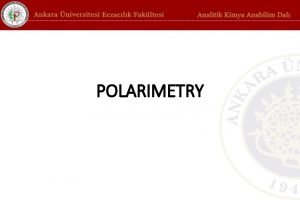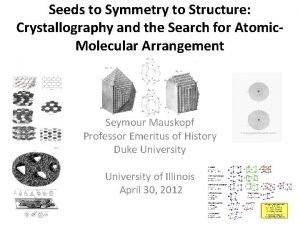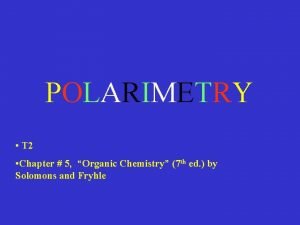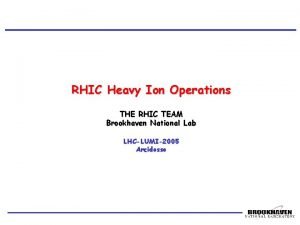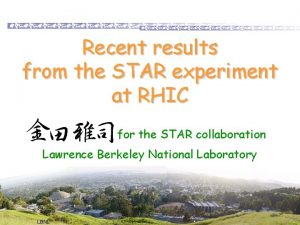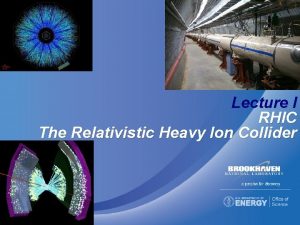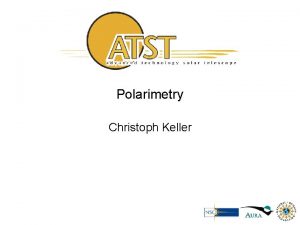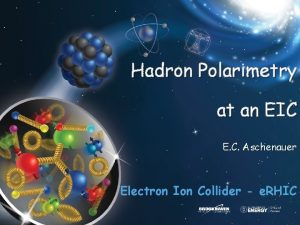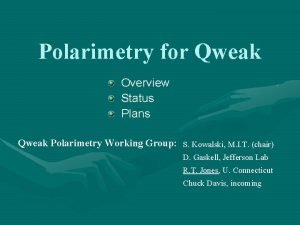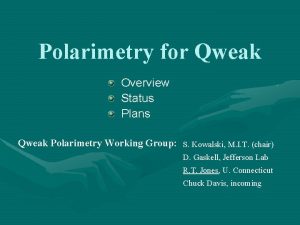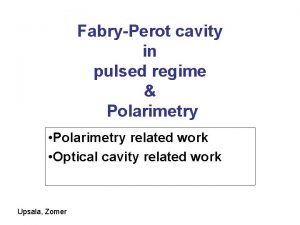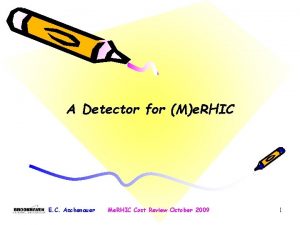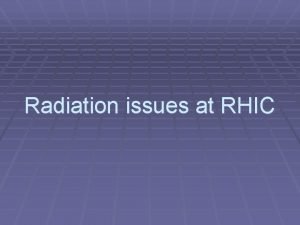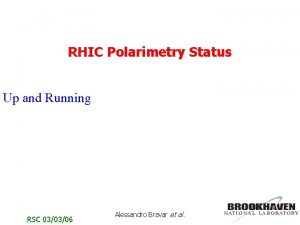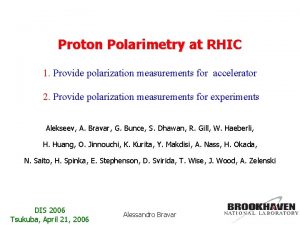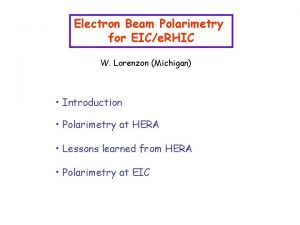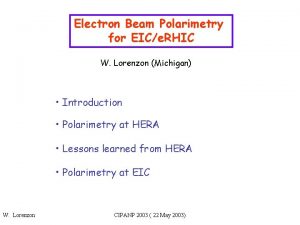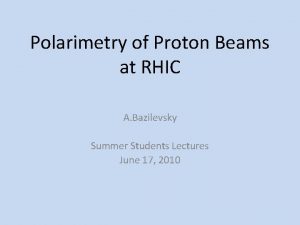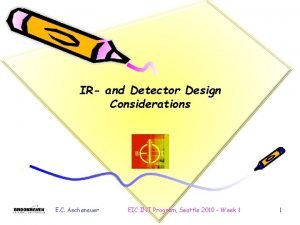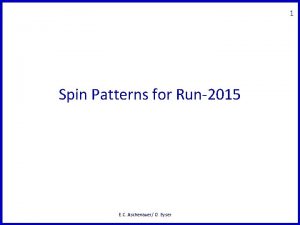Polarimetry Requirements for e RHIC E C Aschenauer

























- Slides: 25

Polarimetry Requirements for e. RHIC E. C. Aschenauer PSTP-2013, Charlotesville, VA 1

The Pillars of the e. RHIC Physics program s p t Requirements from Physics: h r s f 2 E H y o 33 q High Luminosity ~ 10 i cm-2 s-1 pand higher. D l a s n q Flexibleecenter of mass e energyi + d polarised 3 g i q Electrons and protons/light nuclei (p, He or D) highly n l 1 c r q Wide range of nuclear beams (d to U) c d t q a wide acceptance detector with good PID (e/h ando p, K, p) s c P elastic. Ireactions and s r q wide acceptance for protons from n o neutrons m o from nuclear breakuph i o l y i s f o s g W a r i i e t Wide physics program with high requirements on detector and machine performance c n a i s g k E. C. Aschenauer 2 PSTP-2013, Charlotesville, VA o

Deep Inelastic Scattering Kinematics: Measure of resolution power Measure of inelasticity Measure of momentum fraction of struck quark Gluon splits into quarks Quark splits into gluon splits into quarks … 10 -16 m 10 -19 m higher √s increases resolution E. C. Aschenauer PSTP-2013, Charlotesville, VA 3

Example: Longitudinal Spin Structure Can DS and DG explain it all ? E. C. Aschenauer Contribution to proton spin to date: Gluon: 20% (RHIC) Quarks: 30% (DIS) MISS 50% low x PSTP-2013, Charlotesville, VA 4

present vs e. RHIC kinematic coverage RHIC pp data constraining Δg(x) in approx. 0. 05 < x <0. 2 2 likewise for data plotted at x. Q T=2 p. T/√S 20 e. RHIC extends x coverage by up to 2 decades x 0 5 2 V e G IC H R e 5 x 0 0 1 V e G IC H R e 1 ge a st lowest x so far 4. 6 x 10 -3 COMPASS (at Q 2=1 Ge. V 2) E. C. Aschenauer PSTP-2013, Charlotesville, VA 5

g 1 p the way to find the Spin hep-ph: 1206. 6014 (M. Stratmann, R. Sassot, ECA) cross section: p. QCD scaling violations 5 x 250 starts here 5 x 100 starts here dramatic reduction of uncertainties: world data now e. RHIC 5 x 100/250 Ge. V E. C. Aschenauer PSTP-2013, Charlotesville, VA 6

Can we solve the spin sum rule ? gluon spin Dg✔ ✔ total quark spin DS current data orbital angular momentum can be extracted through exclusive reactions w/ e. RHIC data for details see D. Mueller, K. Kumericki S. Fazio, and ECA ar. Xiv: 1304. 0077 • can expect ~5 -10% uncertainties on ΔΣ and Δg BUT need to control systematics E. C. Aschenauer PSTP-2013, Charlotesville, VA 7

Impact on ∫Dg from systematic uncertainties ar. Xiv: 1206. 6014 Dominant systematics: Luminosity Measurement Relative Luminosity relative luminosity à needs to be controlled better then ALL à ~10 -4 at low x Absolut polarization measurements: electron Pe and hadron Pp Need systematics E. C. Aschenauer ≤ 2% PSTP-2013, Charlotesville, VA 8

Polarization and Luminosity Coupling q Concept: Use Bremsstrahlung ep epg as reference cross section Ø normally only g is measured Ø Hera: reached 1 -2% systematic uncertainty q BUT: so l a t u t b portan ation level m I à coupling between polarizationpomeasurement uncertainty and is r n a o l i t a l e onlylumi-measurement orr c t o t n n e uncertainty achievable for r r cur onito h m c n o u t b ams ion e t need a b s i h r t a pol for bo à no experience no polarized ep collider jet à have started to estimate a with the help of our theory friends hopefully a is small E. C. Aschenauer PSTP-2013, Charlotesville, VA 9

What do we know E. C. Aschenauer PSTP-2013, Charlotesville, VA 10

Electron accelerator to be build polarized leptons 5 -20 (30) Ge. V Polarisation at e. RHIC Existing = $2 B p e- 70% e- longitudinal beam polarization Polarized protons 50 -250 Ge. V Polarized light ions He 3 166 Ge. V/u currently 55% @ 250 Ge. V p-beam polarization will be improved @ e. RHIC through more snakes ~70% Bunch by Bunch Polarization Direction each bunch can have a different polarization direction protons electrons minimizes long term systematics due to helicty direction HERA: one helicity state for all e-bunches for ~3 month E. C. Aschenauer PSTP-2013, Charlotesville, VA 11

RHIC Hadron Polarimetry Polarized hydrogen Jet Polarimeter (HJet) Source of absolute polarization (normalization of other polarimeters) Slow (low rates needs looong time to get precise measurements) Proton-Carbon Polarimeter (p. C) @ RHIC and AGS Very fast main polarization monitoring tool Measures polarization profile (polarization is higher in beam center) and lifetime Needs to be normalized to HJet Local Polarimeters (in PHENIX and STAR experiments) Defines spin direction in experimental area Needs to be normalized to HJet All of these systems are necessary for the proton beam polarization measurements and monitoring E. C. Aschenauer PSTP-2013, Charlotesville, VA 12

RHIC Hadron Polarisation Account for beam polarization decay through fill P(t)=P 0 exp(-t/tp) growth of beam polarization profile R through fill p. Carbon polarimeter Collider Experiments SSA r o f d 3. 4 n a A DS r o f y taint r -2% e 1 c n o u t : t l % correlation 6. 5 duce of Resu e d r e v o t e i ch ing Have a ery challeng d. P/dt to d. R/dt v for all 2012 fills will be x=x 0 at 250 Ge. V Polarization lifetime has consequences for physics analysis à different physics triggers mix over fill different <P> E. C. Aschenauer PSTP-2013, Charlotesville, VA 13

RHIC: Polarisation-Bunch Current Correlation Data from 2012 -Run: Correlator vs. Energy Up Spin 0. 03 0. 02 0. 01 0 -0. 02 -0. 03 -0. 04 -0. 05 -0. 06 -0. 07 Correlator ts: n e m e sur a e m n Jet o i B 1 H 50 100 150 200 250 300 risat for e l h a t i a l r o n e i p B 2 ction mat ron t d e a a g r h r f a f ular Y 1 genious t ts o c n e e l o m m e mo NI Improv sly monitor d more ho. Y 2 C n i ) C ou an E kin( o t C t c e continu er lifetime r t e e s d o to C cl ng s p o r l s o r f t d e o Energy [Ge. V] c t n i e f cale det rime s a i l y o S g p r r e Correlator vs. Energy Down Spin o f y g o the p. C alibrate en l o chn e c t 0. 03 e r w o t c e can Small t e 0. 02 d e anti-correlation v i t a 0. 01 alternbetween polarisation and 0 E. C. Aschenauer -0. 01 0 -0. 02 -0. 03 -0. 04 -0. 05 -0. 06 -0. 07 -0. 08 Correlator between polarisation and bunch current at injection which washes out at collision energies 50 100 150 200 250 300 B 1 B 2 Y 1 Y 2 Energy [Ge. V] PSTP-2013, Charlotesville, VA 14

e. RHIC Lepton Beam Ø How to generate 50 m. A of polarized electron beam? Polarized cathodes are notorious for dying fast even at m. A beam currents Ø One possibility is using the idea of a “Gatling” electron gun with a combiner? 20 cathodes one proton bunch collides always with electrons from one specific cathode sign e d r o tect e D d n r IR a o 2 -tagge t n i r mete ow Q i l r : a d e l n g o Important questions: n a p y lle segatling gun tor etrto i r pton fluctuation n m e Cqha. What o v m m s o m y n C s is the expected in polarisation from cathode in the tra te a. Jlab gy a osity e r r l n g i e b i e n m s t E u s n à from experience 3 -5% L I e po ith n r o w i u t s r a a e s e i h etry olar to m oget p m t l m a y n r s i q What in bunchim current ete for theoselectron itud gfluctuation ado we expect n i r o o l l a p C à à limited by n Surface need see what we obtain from prototype gun tto ted Charge, n e e n m o g p com à se n o i t a q Do pwe ris that the collision deteriorates the electron polarisation. olaexpect A problem discussed for ILC influences where we want to measure polarisation in the ring q How much polarisation loss do we expect from the source to flat top in the ERL. Losses in the arcs have been significant at SLC q Is there the possibility for a polarisation profile for the lepton bunches if then in the longitudinal direction can be circumvented with 352 MHz RF E. C. Aschenauer PSTP-2013, Charlotesville, VA 15

Detector and IR-Design All optimized for dedicated detector Have +/-4. 5 m for main-detector à p: roman pots / ZDC à e: low Q 2 -tagger e. RHIC-Detector: collider detector with -4<h<4 rapidity coverage and excellent PID e p e. RHIC Detector 100$-question: Can we combine low Q 2 -tagger lumi-monitor and compton polarimeter in one detector system? E. C. Aschenauer PSTP-2013, Charlotesville, VA 16

A possible layout Polarimeter Laser pair spectrometer ECAL ~ small θ e’-tagger laser polarisation needs to be monitored p e q Allows to measure polarisation before and after collision by changing focus q ECal: needs to be radiation hard (sees synchrotron radiation fan) q possible technology diamante calorimeter ILC FCal q will be used to detect compton photons and bremsstrahlungs photons q challenge to disentangle compton and bremsstrahlungs photons triggering q e’-tagger: q detect low Q 2 scattered electrons quasi-real photoproduction physics q detect lepton from compton scattering q pair spectrometer: alternative luminosity measurement E. C. Aschenauer PSTP-2013, Charlotesville, VA 17

Summary e h t f o s Ø ar. Xiv: 1212. 1701 & 1108. 1713 ue p g u a o e r l l well advanced g q e. RHIC Machine, IR and design very and many details o c C I y H m are studied R e o t s D u s A k h Ø will have a prototype gatling gun available soon C n t i d ha w n T a impact on polarimeter aand e t y Ø studyan systematic effects lumi-monitor F r T o M b C design a I l l E n o o c i L s i o c t q Performance determined BN Requirements fromdyphysics e r n p o o i h t b g a y i q First studies on relativeer luminosity requirements and polarization z h i r v e a l e doneth o e measurements have been p s e t m n z n o i o l e c r auncertainties d m elsystematic e Ø impactwon a e r r h u o e s d t a n W e a q having large luminosityomeans there ism the need to control the n y r t t to very ilow levels s c systematic uncertainties o e l n i e m u l Ø need to understand nd the limitations in polarisation and luminosity a measurements q A lot of work was done in the last years on EIC E. C. Aschenauer PSTP-2013, Charlotesville, VA 18

BACKUP E. C. Aschenauer PSTP-2013, Charlotesville, VA 19

What needs to be covered BY THE DETECTOR e’ e g, p, J/Y g. L* (Q 2) x+ξ x-ξ ~ ~ H, H, E, E (x, ξ, t) p’ p Inclusive Reactions in ep/e. A: q q t Physics: Structure Fcts. : g 1, F 2, FL Very good electron id find scattered lepton Momentum/energy and angular resolution of e’ critical scattered lepton kinematics Semi-inclusive Reactions in ep/e. A: q Physics: TMDs, Helicity PDFs flavor separation, dihadron-corr. , … Kaon asymmetries, cross sections q Excellent particle ID: p±, K±, p± separation over a wide range in h q full F-coverage around g* q Excellent vertex resolution Charm, Bottom identification Exclusive Reactions in ep/e. A: q Physics: GPDs, proton/nucleus imaging, DVCS, excl. VM/PS prod. q Exclusivity large rapidity coverage rapidity gap events q ↘ reconstruction of all particles in event q E. C. high. Aschenauer resolution in t Roman pots Charlotesville, VA 20 PSTP-2013,

e. RHIC-Detector Design Concept Upstream low Q 2 tagger -h E C A H L R C I A P C L W H O ECAL W-Scintillator DIRC/proximity RICH R I C H E C A L H C W A S L c i n To Roman Pots h PID: -1<h<1: DIRC or proximity focusing Aerogel-RICH 1<|h|<3: RICH Lepton-ID: -3 <h< 3: e/p 1<|h|<3: in addition Hcal response & g suppression via tracking |h|>3: ECal+Hcal response & g suppression via tracking -5<h<5: Tracking (TPC+GEM+MAPS) E. C. Aschenauer PSTP-2013, Charlotesville, VA 21

e. RHIC: high-luminosity IR 20 x 250 Proton beam lattice p G. Ambrosio et al. , IPAC’ 10 e Nb 3 Sn 20 x 250 /m T 0 20 e. RHIC - Geometry high-lumi IR with β*=5 cm, l*=4. 5 m and 10 mrad crossing angle 1034 cm-2 s-1 Generated Quad aperture limited RP (at 20 m) accepted 10 mrad crossing angle and crab-crossing High gradient (200 T/m) large aperture Nb 3 Sn focusing magnets Arranged free-field electron pass through the hadron triplet magnets Integration with the detector: efficient separation and registration of low angle collision products q Gentle bending of the electrons to avoid SR impact in the detector q q © D. Trbojevic, B. Parker, S. Tepikian, J. Beebe-Wang E. C. Aschenauer PSTP-2013, Charlotesville, VA 22

Integration into Machine: IR-Design Outgoing electron direction currently under detailed design à detect low Q 2 scattered leptons à want to use the vertical bend to separate very low-Q e’ from beam-electrons à can make bend faster for outgoing beam faster separation à for 0. 1 o<Q<1 o will add calorimetry after the main detector space for low-Q e-tagger E. C. Aschenauer PSTP-2013, Charlotesville, VA 23

Lepton Polarization q Method: Compton backscattering q Questions, which need still answers Ø how much does the polarization vary from bunch to bunch yes: need a concept to measure bunch by bunch polarisation in an ERL no: measure the mean of all bunches what is done now at JLab HERA t Ø is there the possibility for a polarization profile a y aint t r e c n t: we measure %it u? yes: Rhow 4. esulcan 1 d e hievmuch c a e no: makes things easier v Ha 572 nm pulsed laser transport system: ~80 m laser light polarisation measured continuously in box #2 E. C. Aschenauer PSTP-2013, Charlotesville, VA 24

What Do we know on Dg(x) q Scaling violations of g 1 (Q 2 -dependence) give indirect access to the gluon distribution via DGLAP q RHIC polarized pp collisions at midrapidity direct access to gluons (gg, qg) evolution. q Rules out large DG for 0. 05 < x < 0. 2 Integral in RHIC x-range: Contribution to proton spin to date: Gluon: 20% Quarks: 30% e. RHIC Brainstorming Meeting, BNL, Aug. 2013 E. C. Aschenauer 25
 Polarimetry definition in chemistry
Polarimetry definition in chemistry Biots law polarimetry
Biots law polarimetry Polarimetry organic chemistry
Polarimetry organic chemistry Rhic brookhaven
Rhic brookhaven Rhic ags users meeting 2020
Rhic ags users meeting 2020 Rhic
Rhic Orbital revolution
Orbital revolution Treserva lathund
Treserva lathund Vad står k.r.å.k.a.n för
Vad står k.r.å.k.a.n för Centrum för kunskap och säkerhet
Centrum för kunskap och säkerhet Läkarutlåtande för livränta
Läkarutlåtande för livränta Påbyggnader för flakfordon
Påbyggnader för flakfordon Inköpsprocessen steg för steg
Inköpsprocessen steg för steg Anatomi organ reproduksi
Anatomi organ reproduksi Egg för emanuel
Egg för emanuel Tack för att ni har lyssnat
Tack för att ni har lyssnat Varians
Varians Tidbok yrkesförare
Tidbok yrkesförare Rutin för avvikelsehantering
Rutin för avvikelsehantering Biologiska arvet
Biologiska arvet Kontinuitetshantering i praktiken
Kontinuitetshantering i praktiken Myndigheten för delaktighet
Myndigheten för delaktighet Presentera för publik crossboss
Presentera för publik crossboss Var 1721 för stormaktssverige
Var 1721 för stormaktssverige Tack för att ni lyssnade
Tack för att ni lyssnade Att skriva debattartikel
Att skriva debattartikel
